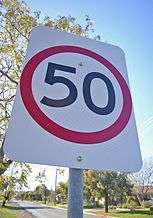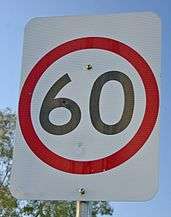Speed limits in Australia
Speed limits in Australia range from 5 kilometres per hour (3.1 mph) shared zones to 130 kilometres per hour (81 mph). In the Northern Territory four highways have 130 kilometres per hour (81 mph) zones. Speed limit signage is in km/h since metrication on 1 July 1974. All speed limits (with the sole exception of the South Australian school and roadworks zones which are signposted at 25 km/h) are multiples of 10 km/h – the last digit in all speed signs is zero.[1] Speed limits are set by state and territory legislation albeit with co-ordination and discussion between governments.
Common limits
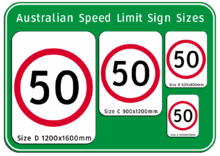
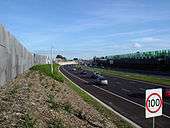

Australian states and territories use two "default" speed limits. These apply automatically in the absence of 'posted' speed restriction signage. The two default speed limits are:
- within built-up areas, 50 kilometres per hour (31 mph), except for the Northern Territory which remains at 60 kilometres per hour (37 mph)
- outside built-up areas, 100 kilometres per hour (62 mph); two exceptions are Western Australia and the Northern Territory at 110 kilometres per hour (68 mph)
Common speed zones below the default built up area 50 km/h limit are:
- Shared zones (signposted areas where pedestrians and motorised traffic share the same space) are 10 kilometres per hour (6.2 mph).
- School zones are variable speed zones, with a 40 kilometres per hour (25 mph) limit applying during gazetted school terms (which may include pupil-free days)[2] and at specific times of the day when children are expected to be present. In South Australia, the limit is 25 kilometres per hour (16 mph). A minority of school zones have flashing lights to indicate when the lower speed limit applies.
- 40 km/h zones. A number of local governments have implemented lower speed limits, typically 40 km/h, in certain areas, such as shopping precincts, whole suburbs such as Balmain and Rozelle in Sydney, or areas with high pedestrian activity.
Common speed zones above the default limits are:
- Many sub-arterial roads are zoned 60 kilometres per hour (37 mph).
- Major connector roads and smaller highways are zoned 60 kilometres per hour (37 mph), 70 kilometres per hour (43 mph), 80 kilometres per hour (50 mph) or 90 kilometres per hour (56 mph). 50 km/h speed limit sign60 km/h speed limit sign
- Some highways and freeways are zoned 110 kilometres per hour (68 mph).
- Most of the Stuart, Arnhem, Barkly and Victoria highways in the Northern Territory are zoned 130 kilometres per hour (81 mph).
The "END" speed limit sign is increasingly used throughout Australia to signal the end of a posted speed restriction, or built-up area "default" speed-limit leading to the jurisdiction's "rural" default speed limit. It contains the word "END" and a number in a black circle beneath this, representing the ceasing speed-limit. It is typically used where, according to AS1742.4 the road beyond has certain hazards such as hidden driveways, poor camber, soft edges and other hazards where the road authority feels a posted speed limit sign might be too dangerous or otherwise unwarranted. It is intended therefore to invoke particular caution. This sign is used as a direct replacement for the slash-through speed derestriction signs common in Europe and elsewhere.
Speed limits are enforced in all areas of the country. Tolerance ranges from 3% to 10% in most states but only 3 km/h in Victoria, an issue that has caused much controversy in that state, especially in light of the fact that earlier Australian Design Rules specified that vehicle speedometers may have up to 10% leeway in accuracy. This was updated in 2006 to require that the "speed indicated shall not be less than the true speed of the vehicle."[3] Detection measures used are radar, LIDAR, fixed and mobile speed cameras (using various detection technologies), Vascar, pacing and aircraft.
Default speed limits by state and territory
Despite introduction of model national road rules by the states in 1999, Western Australia and the Northern Territory retain different default speed limits. The table below indicates the default speed limits along with typical school zone limits and the highest zone in each locality.
In the external territories, and in some special cases (such as Lord Howe Island, NSW), the speed limits may differ significantly from those found across the rest of the nation.
| State / territory | School zone[4] | Built-up area | Rural area | Highest speed zone |
|---|---|---|---|---|
| Australian Road Rules[5] | number on school zone sign | 50 | 100 | number on speed-limit sign |
| Australian Capital Territory | 40 | 50 | 100 | 100 |
| New South Wales | 40 on all roads 40 km/h or more 30 in designated 30 km/h zones in Manly and Liverpool | 50 | 100 | 110[6] |
| Northern Territory | 40 | 60[7][8] | 110[9] | 130 |
| Queensland | 40 on roads 70 km/h or less 60 on roads 80 km/h and some 90/100 km/h 80 on roads 110 km/h and some 90/100 km/h | 50 | 100 | 110 |
| South Australia | 25[10] on roads 60 km/h or less | 50 | 100[10] | 110 |
| Tasmania | 40 on roads 70 km/h or less 60 on roads 80 km/h or more | 50 | 100 | 110[11] |
| Victoria | 40 on roads 70 km/h or less 60 on roads 80 km/h or more | 50 | 100 | 110 |
| Western Australia | 40 on roads 70 km/h or less 60 on roads with 80 km/h or 90 km/h | 50[12][13] | 110[12][14] | 110 |
| External territories | ||||
| Christmas Island[15] | 40 | 40 | 90 | 90 |
| Cocos (Keeling) Islands | -- | 30 | 50 | 50 |
| Norfolk Island[16] | 30 | 30 - Kingston Foreshore 40 - Burnt Pine Central Business District | 30 - Norfolk Island National Park 50 - Other Areas | 50 |
| Special cases | ||||
| Lord Howe Island[17] | -- | -- | -- | 25 |
Signage
.svg.png) Standard speed limit sign
Standard speed limit sign.svg.png) Restricted speed area sign
Restricted speed area sign Local traffic area sign
Local traffic area sign Shared zone sign
Shared zone sign.svg.png) School zone sign in NSW and Victoria
School zone sign in NSW and Victoria.svg.png) Speed limit ends sign
Speed limit ends sign.svg.png) Restricted speed area ends sign
Restricted speed area ends sign End shared zone sign
End shared zone sign Advisory speed sign
Advisory speed sign Exit advisory speed sign
Exit advisory speed sign.svg.png) Speed limit change ahead sign
Speed limit change ahead sign.svg.png) Speed limit change ahead sign (Victoria)
Speed limit change ahead sign (Victoria)
Historical limits
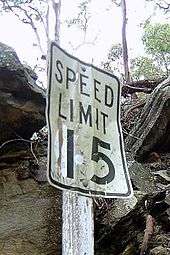
Historically, Australia operated a simple speed limit system of urban and rural default limits, denoted in miles per hour. As part of metrication in 1974, speed limits and speed advisories were converted into kilometres per hour, rounded to the nearest 10 km/h, leading to small discrepancies in speed limits. Signage changed from a North American-style black and white textual sign to a design based on metric signage in use in New Zealand with black number in red annulus (or circle) on white, itself a derivative of the European standard number in red circle design.
Urban limits
The urban default, which prior to the 1930s was 30 miles per hour (48 km/h), applied to any "built up area", usually defined by the presence of street lighting. This limit was progressively increased to 35 miles per hour (56 km/h) over the next 30 years by each of the states and territories, with New South Wales being the last to change in May 1964. South Australia adopted 35 miles per hour (56 km/h) on 30 November 1950 along with the "new short-right hand turn" (in place of a hook turn). [18]
Metrication led to the default urban limits of 35 miles per hour (56 km/h) being converted to 60 km/h, an increase of 3.7 kilometres per hour (2.3 mph).
In the late 1990s and early 2000s, the 60 kilometres per hour (37 mph) urban default limit was progressively lowered to 50 kilometres per hour (31 mph) nationally for reasons of road, and especially pedestrian, safety. However, many existing roads, especially subarterial roads in urban areas, have had 60 kilometres per hour (37 mph) limits posted on them. Queensland's Manual of Uniform Traffic Control Devices (Speed Controls) states that 60 kilometres per hour (37 mph) is the general minimum speed limit for traffic-carrying roads.[19] The Northern Territory has retained the 60 kilometres per hour (37 mph) limit; however, 50 kilometres per hour (31 mph) is also a common speed limit (particularly in residential areas).
Rural limits
Outside of built up areas, a prima facie speed limit applied. In New South Wales and Victoria, speed limit was 50 miles per hour[20]:31, 76 (80 km/h in New South Wales[20]:76 after metrication). In the 1970s however, most state speed limits were gradually replaced by absolute limits.[20] An absolute speed limit of 70 miles per hour (113 km/h) was introduced to Victoria in 1971, as a trial.[20]:31 This was subsequently reduced to 60 miles per hour (97 km/h) in late 1973. South Australia introduced an absolute speed limit of 60 miles per hour (97 km/h) in 1974.
With metrication in 1974, the rural defaults of 60 miles per hour (97 km/h) and 65 miles per hour (105 km/h) became 100 kilometres per hour (62 mph) and 110 kilometres per hour (68 mph) respectively. The 50 mph limit in New South Wales became a limit of 80 km/h.
New South Wales introduced an absolute speed limit of 100 kilometres per hour (62 mph) in 1979, replacing the limit of 80 kilometres per hour (50 mph)[20]:11, 13 The Northern Territory introduced an absolute speed limit of 110 kilometres per hour (68 mph) in 2007, along with 130 kilometres per hour (81 mph) zones on the Territory's four major highways.
NT open speed limits
The Northern Territory had no blanket speed limits outside major towns until January 2007, when a general rural speed limit of 110 km/h (68 mph) was introduced, although four major highways had higher 130 km/h (81 mph) zones.[21] Speed-limit advocates note that the per-capita fatality rate in 2006 was the highest in the OECD and twice the Australian average.[22] In 2009, the opposition (Country Liberal Party) unsuccessfully sought the removal of the 130 kilometres per hour (81 mph) limits on three out of the four highways where it applied, arguing that total fatalities in the Northern Territory had increased significantly during the first two years of the speed limit. In argument against the motion, the government provided more detailed statistics than normally published; these statistics showed a reduction in fatalities along the highways where 130 kilometres per hour (81 mph) limits were introduced.[23][24][25] In 2011 the opposition argued for a return to "open speed limits" .[26] For the 2012 election the Country Liberals' transport policy promised an evidence-based approach.[27] After winning government, de-restriction of Stuart Highway was proposed;[28][29] a planned 12-month de-restriction was initiated on 1 February 2014. The trial on 200 kilometres (120 mi) of Stuart Highway was expanded later in the year to another 72 kilometres (45 mi), and continued indefinitely in January 2015 during a review of the initial results since "in the first 11 months, there were no recorded fatalities."[30] From September 2015, a 336 kilometres (209 mi) stretch of Stuart Highway between Barrow Creek and Alice Springs had speed limits removed for a 12-month trial.[31][32][33] 130 km/h (81 mph) speed limits were restored on 20 November 2016 due to the electoral loss of the Country Liberal Party.[34]
Derestriction signs in NSW
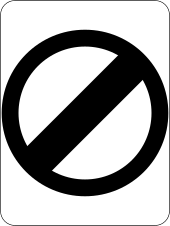
Often the start of rural default 'limits' or prima facie allowances were signalled by use of the speed derestriction sign, catalogued R4-2 in AS1742.4. (2009 edition has dropped from reference the R4-2 speed derestriction). The speed derestriction sign (//) had developed 'different meaning' over time at state and territory level, although its contract-meaning under "The United Nations Convention on Road Traffic, Signs & Signals" where the sign is catalogued "C,17a", is; "End of all local prohibitions imposed on moving vehicles" and has never changed. In the Northern Territory, they designated the end of speed restrictions. In Victoria and Western Australia they meant that the rural default speed limit applied, whilst in New South Wales, they indicated that the prima facie 50 miles per hour (80 km/h) limit applied.
New South Wales's prima facie 50 miles per hour (80 km/h) limit, often signed by derestriction signs, was only enforced in cases where a driver's speed could be demonstrated to be excessive or dangerous in the context of prevailing road conditions. This was somewhat similar in principle to "reasonable and prudent" limits in other jurisdictions. This led to the widespread but misleading belief that no limit applied, and that derestriction signs indicated an "unlimited" limit. This belief, coupled with repeated studies showing 85th percentile speeds in excess of 120 kilometres per hour (75 mph) on major routes, comparatively high road tolls, difficulty in prosecuting speeding offences, and the variance in meaning of the derestriction sign across states, led New South Wales to harmonise its rural default limit to 100 kilometres per hour (62 mph) in 1978. The use of derestriction signs in New South Wales was officially discouraged, and on state controlled routes, 100 kilometres per hour (62 mph) signs were progressively used instead.
See also
References
- NSW speed zoning guidelines (PDF). Roads and Traffic Authority NSW. 2011. p. 9.
- http://smh.drive.com.au/schools-out-but-cameras-on-duty-20110716-1hj01.html
- Vehicle Standard (Australian Design Rule 18/03 – Instrumentation) 2006
- "School Crossings Report" (PDF). ACT Government. TAMS. Retrieved 9 April 2009.
- http://www.ntc.gov.au/filemedia/Reports/ARR_February_2009_final.pdf
- "Driving". New South Wales Government. Roads and Traffic Authority. Archived from the original on 6 November 2008. Retrieved 21 December 2008.
- Road Users' Handbook (pdf). Northern Territory Government. ISBN 978-0-646-91531-9. Retrieved 28 January 2014.
- Traffic Regulations (NT) r 77
- Traffic Regulations (NT) r 77A
- "Speed Limits". Government of South Australia, Department of Planning, Transport and Infrastructure. Retrieved 24 February 2013.
- Max Cameron (October 2009). "Economic Evaluation of the Introduction of Lower Rural Default and National Highway Speed Limits in Tasmania. Table 1: State Road Network roads designated for speed limit reductions. Traffic parameters and mean speeds for each road category" (PDF). Monash University Accident Research Centre. Retrieved 15 September 2012.
Rural roads with 110 km/h speed limits...Divided Category 1 Trunk Roads 67.3 (km in length)... 110 (km/h free mean speed for cars and light commercial vehicles)...Undivided Cat. 1 Trunk Roads 238 (km)...105 (km/h free mean speed for cars and light commercial vehicles)
- Drive Safe. A handbook for Western Australian road users. (PDF), Government of Western Australia, Department of Transport, 11 January 2013, p. 47, retrieved 15 February 2013
- Road Traffic Code 2000 (WA) r 11
- Road Traffic Code 2000 (WA) r 3
- http://www.christmas.shire.gov.cx/Works_and_Services/Transport_and_Works/4DL%20Brochure%20oustsidev4.pdf
- http://www.info.gov.nf/adminforms/motor%20vehicle%20rego/NI%20Traffic%20handbook%20v2.pdf
- http://www.lhib.nsw.gov.au/index.php?option=com_jentlacontent&view=enhanced&id=246&Itemid=830
- "Follow-The-Leader In New Right Turn". The Advertiser (Adelaide). South Australia. 30 November 1950. p. 3. Retrieved 16 December 2019 – via Trove.
- "Queensland Manual of Uniform Traffic Control Devices" (PDF). Queensland Government. Department of Main Roads. Retrieved 27 March 2009.
- "A Review of Rural Speed Limits in Australia". Commonwealth Government of Australia. Commonwealth Department of Transport. Retrieved 27 March 2009.
- "Speed limits to be introduced on NT open roads". Australian Broadcasting Corporation. 2 November 2006. Retrieved 17 September 2009.
The open speed limit for the Territory will end. On our major highways the maximum speed will be 130 kilometres per hour (81 mph). And on our other open roads, the default will be 110 kilometres per hour (68 mph).
- "NT has worst road toll in OECD nations". Retrieved 27 April 2010.
A report on road deaths in 2007 shows the Northern Territory had by far the highest per capita rate of fatalities when compared with the rest of Australia and OECD countries.
- "MOTION Reinstatement of Open Speed Limits". Retrieved 17 May 2010.
We have adopted a speed limit on our main highways that is responsible and workable; the road toll is down in areas where 130 kilometres per hour (81 mph) limits were introduced on 1 January 2007. Tragically, five people have been killed in 130 kilometres per hour (81 mph) zone areas this year, seven in 2008, and six in 2007. This compares to an average of more than 12 people per year in the five years prior to speed limits, with 16 people dying in 2002, 16 in 2003, 11 in 2004, 14 in 2005, and six in 2006. The fatalities recorded in the now 130 kilometres per hour (81 mph) zone on the Stuart Highway are particularly tragic, averaging over nine fatalities per year prior to speed limits. Since the introduction of speed limits this has reduced to an average of five fatalities per year to date - five too many.
- "Revheads' dream: bid to scrap NT speed limits". 18 August 2009. Retrieved 17 May 2010.
The Opposition's transport spokesman Adam Giles says despite the introduction of speed limits, the road toll has increased. In 2006, 44 people were killed, and the following year, the toll climbed by 13 deaths. In 2008, it reached 75. However, this year's road toll is 17, compared with 45 for the same period in 2008. The Opposition is planning to debate a motion in the Legislative Assembly today to have speed limits lifted on parts of main highways.
- "Northern Territory Crash Statistics". Northern Territory Transport Group. Retrieved 16 May 2010.
- Adam Giles (10 August 2011). "SPEED LIMITS". Country Liberal Party. Retrieved 1 March 2012.
Open speed limits were removed in 2007 by the current Labor Government after undertaking a road safety review...Official road toll figures in 2006 were 44. Following the removal of open speed limits the toll increased to 57 and then 75. Last year it was 50, higher still than when speed limits were removed...The Country Liberals - within the first 100 days of government - will review the state of the Territory’s major arterial routes and identify safe locations for open speed limits to be reintroduced.
- Terry Mills. "Road Safety - Deadly serious - Reducing risks on our roads" (PDF). Country Liberal Party. Retrieved 13 September 2012.
Speed Limits. A Country Liberals Government will adopt an evidence-based approach to speed limits on our major highways. We will conduct an audit of the impact of the introduction of speed limits and will base any future decisions around that information.
- "Northern Territory chief minister considers scrapping speed limit on the Stuart Highway". Herald Sun. News Limited Network. 11 September 2012. Retrieved 15 September 2012.
Newly elected Northern Territory Chief Minister Terry Mills indicated he was willing to dump the 130 kilometres per hour (81 mph) speed limit on the Stuart Highway. The road did not have a set speed limit until 1 January 2007...Mr Mills and the CLP took power last month and was today asked whether he planned to scrap the rural speed limits. He suggested the 1,100 kilometres (680 mi) of road between Katherine and Alice Springs could possibly exist without a speed limit.
- SAM HALL; TOBY HAGON; DAVID MCCOWEN. "Speed limits may go in parts of Australia". Retrieved 10 May 2013.
In the six years since, more people have died on Northern Territory roads (307) than in the six years before the change (292). Fatalities on the Stuart, Victoria and Barkly Highways have almost halved since speed limits were introduced, from 62 to 32, but the statistics show that the drop is more to do with fewer drink-drivers and the increased use of seatbelts by Territory drivers.
- "Permanent speed de-restriction looms following successful evidence-based trial, but not everyone is happy".
Provisional figures reveal that in the first 11 months, there were no recorded fatalities. The government argues 12 fatalities were recorded on the same patch of road between 2004 and 2013, with speed ruled out as a key factor in each incident. "Following the commencement of the open speed trial on a 200 kilometres (120 mi) stretch of road from south of Barrow Creek to north of Alice Springs, and an extension of the trial section to include a 72 kilometres (45 mi) stretch of road on the Stuart Highway between the Ali Curung Rail Overpass to just north of Barrow Creek, the Northern Territory Department of Transport will now undertake a review of the trial to determine its success and future viability," Territory deputy Chief Minister Peter Chandler said... "The trial will continue during the review period."
- http://www.abc.net.au/local/stories/2013/10/15/3869390.htm
- http://news.drive.com.au/drive/motor-news/leadfooters-hit-the-highway-in-nt-20140201-31trz.html
- http://www.northqueenslandregister.com.au/news/agriculture/general/news/open-speed-limit-not-licence-for-recklessness/2687988.aspx
- http://www.ntnews.com.au/news/northern-territory/open-speed-limits-scrapped/news-story/33dcae476d0290f445965f1e74423871
External links
- Metric Motoring (1973) – Original television advertisements explaining the conversion to metric speed limits. From the National Film and Sound Archive.
